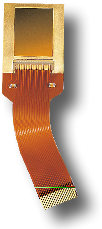Biometrics is the methodology for recognizing or identifying persons based on
physiological or behavioral characteristics. Essentially all security features
are based on a combination of three key concepts. Security can be based on
something you have, something you know or something you are. While tokens or
passwords can copied or stolen, biometric identifiers are much more difficult to
reproduce.
Currenty physical traits which can be used as identifiers include facial
shape, fingerprints, iris patterns, retina patterns, hand geometry, speech,
handwriting / keystroke order and finally even wrist vein patterns. For
these identifiers to be physically compromised it would involve a very gory
operation...
It is the task of biometric products to apply a
mathematical algorithm to the identifier (retina, or fingerprint for example) to determine if a user
is a who they are pretending to be. In devices where a
finger print is the means of identification, a small device will
scan the fingerprint of the user and momentarily record the
fine details. Where fingerprints are concern this may include features such as the
finger prints' hills and valleys, the direction and branching points, line endings and
dozens of other minutiae.
 The fingers features can be acquired optically, thermally based
on temperature differences between the fingertip's valleys and ridges, by a
pressure sensor or via a capacitive sensor which is essentially a
small silicon chip with many thousands of sensing elements. For
instance Infineon's "FingerTIP sensor uses the capacity difference between
the surface of the sensor and the surface of the finger. The capacity measured
at a ridge differs from that at a valley. Thus, about 65.000 capacitors acquire
the data in a field of 224 x 288 pixels and transform it into a digital
signal."
The fingers features can be acquired optically, thermally based
on temperature differences between the fingertip's valleys and ridges, by a
pressure sensor or via a capacitive sensor which is essentially a
small silicon chip with many thousands of sensing elements. For
instance Infineon's "FingerTIP sensor uses the capacity difference between
the surface of the sensor and the surface of the finger. The capacity measured
at a ridge differs from that at a valley. Thus, about 65.000 capacitors acquire
the data in a field of 224 x 288 pixels and transform it into a digital
signal."
Optical sensors, consisting of a lens and/or prism optical system added to a
CCD or CMOS camera, measure light deflections produced by a finger on a sensor
surface. Thermal sensors rely on measuring temperature differences at the
fingertip so they can be influenced by changes in temperature in the surrounding
environment. Generally thermal sensors must operate in a O° C or above
ambient temperature.
Different means of storing the identifiers exist, and while their are
benefits to each method there is no absolute best. Some companies opt to store
all identifiers on a central server, where user information is sent
during authentication. Other technologies store the identifier on the
local hard drive in a highly encrypted format. To minimize the ability of
an individual going around the biometric security features some companies even
enable users of their devices to add special protective layers to the hard
drive. In these configurations the file allocation table (FAT table) is an
integral part of the security system protecting their computer. When the OS
attempts to access the FAT table the software side of the biometric security
system can prompt for an authentication of the user. If the data doesn't match
the hard drive remains physically locked out at the most basic level, rendering
all information stored on it unusable.
Restricted access is good, but what if you are rejected during the
authentication procedure from accessing your own computer? It can happen if you
have a large cut on your finger for instance. In such situations you would be in
the same position as if you had forgotten your password. What would happen if
you were just rejected for no reason, or even worse some one else had a
finger print similar to yours and was able to gain access your computer?
Well the odds are statistically in your favor that neither of these situations
will occur. Currently, some biometric devices boast False Acceptance Rates (FAR)
of as low as 1 in 1 billion, while the industry average sits at about 1 in
10,000. Conversely the False Recognition Rate (FRR) is typically about 2%.
Of all the identifiers in the realm of biometrics the most accurate and
secure are the retinal and iris scanning technologies. As your eyes are
generally speaking very well protected and extremely unique there is much less
room for errors to stand between you and your data. Though on the other hand, if
you experience any kind of physical trauma to your eye you might be out of
luck...
All in all biometrics is the final piece in the security
triangle and the most secure. With the growing number of networked computers,
and volume of sensitive data being stored on those machines the need for a means
of securing data is ever increasing. Biometrics still seem to be marginalized
into the James Bond category as far as the mainstream consumer is concerned. For
instances where security is paramount, it offers a level of reassurance that is not
there with passwords or token security devices. Think of it this way.
If you run a website and your server is stored with hundreds
of other servers at the hosting companies building, would you feel more secure knowing a retina
scanner or hand geometry security device was protecting your server from tampering, or lock and
key?

